6. LAMPS
6.1 LED
The LED technology offered by Regiolux is a sure winner thanks to its high levels of efficiency and low energy consumption. Efficiency here includes low maintenance expense, ruggedness, and a long service life.
Effective temperature management in luminaire construction with LED is important when it comes to meeting all expectations. It ensures the performance characteristics are met and the luminaire has the promised service life.
An effective and passive cooling is the consequence in technical terms. An optimal light control system affects lighting wellbeing, as well as energy efficiency. You are sure to expect high-quality light technology in all our LED luminaires.
As an energy-efficiency option for traditional lighting systems, our LED luminaires also always need to meet basic quality demands on light wellbeing. also performed solid work here too. We have selected specific lumen packages, optimal colour rendition and various colour temperatures for our Regiolux luminaires. Another quality characteristic is our uniformly stable colour locus. Energy efficiency and service life are not always the crucial factors in LED lighting. LED technology gets further plus points when the lighting system also needs quick and frequent switching, long maintenance intervals or special toughness requirements.
Regiolux LED luminaires ensure you can realise sophisticated lighting concepts and provide perfect illumination for your projects.
Our photometric data are created by us with great care. Due to the high dynamics in the LED and LED-driver field, however, the electrical and photometric data indicated by our suppliers comes with a tolerance of typically ±10%.
Therefore, this tolerance also applies to our figures and it indicated by our suppliers on their data sheets. These data sheets can be provided upon request.
6.1.1 LED benefits
- Lower power consumption
- Long service life
- Unlimited switching capability
- Full light right away
- Continuously dimmable
- No IR and no UV radiation
- High impact- and vibration strength
- Small dimensions
- Mercury free
6.1.2 Luminous flux and light yield
Thanks to the rapid development of LED in recent years, they are also able to provide the relatively high quantities of light for general lighting in the technical light area.
The amount of light - or Luminous flux (unit: Lumens) - denotes the total amount of light power emitted by a bulb or luminaire. When the Luminous flux in an LED only relates to the LED module (or an LED spot), this is called the gross luminous flux. This information is dependent on the different operating parameters and is defined by the LED manufacturer. If the module is built into a luminaire, the luminous flux will change due to a change in the operating conditions (such as temperature). Losses also come about as a result of technical light measures carried out on the luminaire (e.g. glare reduction), which means that a reduced luminous flux actually exits the luminaire. This is called the net luminous flux.
According to the definition, the light yield denotes the ratio of the emitted luminous flux to the electrical supply and is given in Lumens per Watt. A distinction must be made between gross and net here. For the gross light yield, the yield luminous flux of the module is used, whereby the electrical connecting line can be calculated with or without the operating device.
In planning programs such as e.g. Relux however, the net light yield is calculated - this is called the luminaire light yield. This is based on the net luminous flux and the system performance of LED and driver. An identifying characteristic in terms of the net figure is data about the operating efficiency of the LED luminaire at precisely 100%. In light technology, this is called absolute photometry. In the meantime the market has come to prefer net values, in particular, when comparing different types of LED luminaire.
Knowledge of gross and net is essential to avoid comparing apples with pears.
6.1.3 Luminous flux and light colour
In contrast to the colour mix comprising red/green/blue, the efficiency of most white-emitting LED is based on the LED chip initially producing blue radiation. This blue light is deflected by a luminescent layer which is e.g. constructed from yellow phosphorus. According to the principle of luminescence conversion, white light is then produced from blue and yellow.
If wanting to produce a warmer light colour, the admixture of light needs additional red components in the luminescent layer. However, these components work less effectively. This is the reason why the LED luminaires of the same type and rating have a lower luminous flux for a warm white light colour compared to variants with a higher colour temperature.
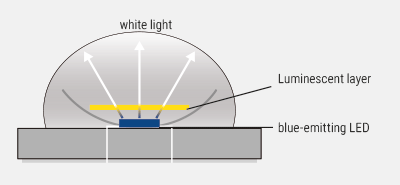
Origin of the light colour in an LED
6.1.4 Binning
Depending on production tolerances of LED, these may vary in their light quantity and colour temperature. However, to achieve a constant light quality with the same level of brightness and light colour, LED are sorted by their values. LED with identical or similar parameters end up in the same bin. The narrower the tolerances, the higher the quality of the “binnings“.
The following terms are often used in connection with binning:
Colour consistency — same light colour from lamp to lampGleiche Lichtfarbe von Lampe zu Lampe
Colour locus constancy — the light colour does not drift due to ageing or when the luminaires are dimmed
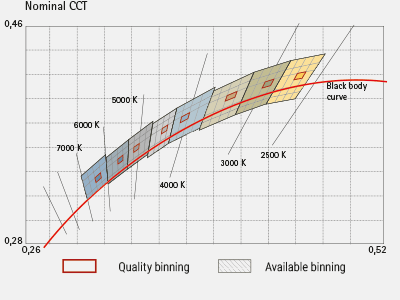
Fine sorting according to colour locus (binning) ensure the quality criteria
of the LED technology.
6.1.5 Thermal management
The LED light is free of infrared radiation. This makes the LED ideal for illuminating sensitive objects, such as in museums or shops. A high proportion of heat arises directly in the LED chip during light generation.This is due to high power density on a small surface. This heat will need to be dissipated since the luminous flux falls at high temperatures and the service life decreases. Construction of the luminaire with appropriate heat dissipation measures is thus very important in ensuring that the operating temperature of the LED is optimal.
6.1.6 Service life
LED used in the technical light area usually have a service life of 50,000 hours and above. This makes the LED one of the longest-lasting lighting mediums available today - without question. In practice, this means a considerable reduction in maintenance costs. Service life information is supplemented by values about degradation and mortality. Degradation, given in Lx, is defined as the reduction in the LED‘s luminous flux due to ageing. Mortality By describes the LED‘s failure rate.
The service life specifications are determined on the basis of the international standards LM 80 and TM 21. In the case of the measuring procedure LM 80 (Measuring Lumen Maintenance of LED Light Sources), the degradation is measured at 3 different ambient temperatures over a period of at least 6,000 hours. For luminaires which are to be classified with 50,000 hours service life, the test period must be extended to more than 8,300 hours and is thus almost one whole year. The LM 80 values determined are then integrated in the calculation method TM 21 (Projection Long Term Maintenance). This is a mathematical model that calculates the expected further degradation by means of extrapolation.
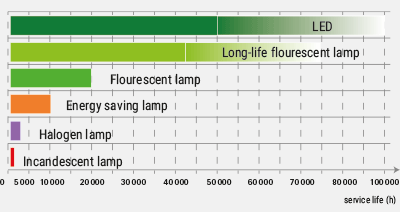
For example, if an LED luminaire features with L80B10, this means that after 50,000 hours of use, the luminous flux has reduced to 80% of its initial value. Ten per cent of LED are allowed to drop below the 80% level, excluding total failures. An important factor influencing both the Luminous flux and the service life is temperature. If there is too much heat, this has a negative effect on the luminous flux and service life.This means effective thermal management with efficient heat dissipation is especially important for LED luminaires
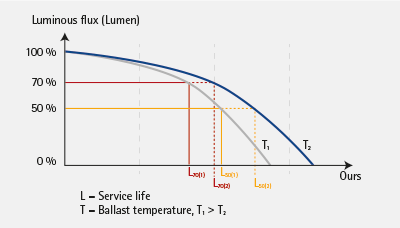
6.1.7 Flicker
The LED as an electronic source of light can react extremely fast to changes in its supply voltage. If this leads to a temporary variation of the emitted light in terms of its intensity or light colour, this is called flickering. Depending on the frequency, flickering is either visible or invisible to the human eye and can lead to adverse effects on health, such as headaches or neurological problems (epilepsy). Reciprocal effects are also known with technical equipment, e.g. during the use of video cameras or bar code scanners.
The occurrence of flickering in LED luminaires does not depend on the lamp but on the quality of the controller that is used. What is decisive here is whether the DC voltage used to operate the LED is still overlaid with a residual ripple. If DALI controllers are used, the LEDs should not be activated by a pulsating signal.
Contact us if you want to illuminate sensitive areas to that effect. We will help you to define the right components.

6.1.8 Photobiological safety
The photobiological safety in accordance with DIN EN 62471 considers the ultraviolet, visible and infra-red radiation of lamps and luminaires. LEDs for lighting purposes in technical lighting usually only emit light in the visible range. The potential for damage, e.g. to the eye’s retina, depends on the wavelength and is at its highest in the blue spectral range (blue light threat). Other influencing factors include luminance, distance to the light source and exposure time.
At Regiolux, the LEDs are chosen in such a way that the risk group (RG) is ≤ 1 from the outset. The aforementioned standard classifies the risk from a source of radiation into four groups. LED luminaires from Regiolux have been tested and comply with the risk groups RG 0 or RG1. There is no hazard from luminaires in these groups during normal user behaviour.
6.1.9 Light management with LED
Light management components further increase the energy efficiency of lighting systems. Even basic presence indicator switches improve the efficiency of such systems at relatively little expense. Since frequent switching of the LED does not result in a reduction of the service life, this lighting medium is ideal for such applications. In addition, the LED immediately starts at 100 % light and no follow-up times need be configured.
Daylight-dependent rules with or without a presence function can be realised with components from the „Light Control“ catalogue chapter or with the prepared master luminaires such as e.g. alvia LC01. Compared to legacy systems with conventional luminaires and magnetic pre-switching, the savings potential of energy costs can reach up to 85%.
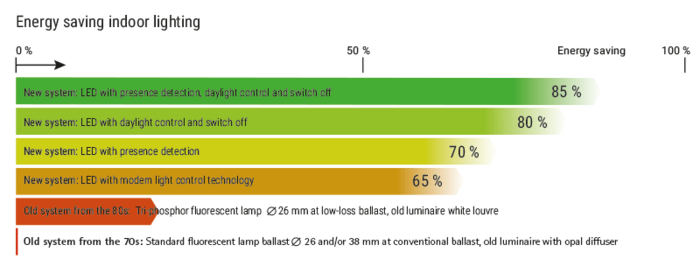
6.1.10 Warranty
Regiolux offers a manufacturer’s warranty that LED products are free from manufacturing and/or material defects when used for their intended purpose for a warranty period of five years for products with a nominal service life ≥ 50,000 operating hours or three years for products with a nominal service life< 50,000 operating hours from the date of invoice. This manufacturer’s warranty applies throughout Europe.